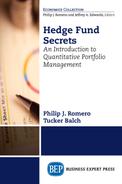Summary
Quantitative trading strategies have come to dominate the world’s major capital markets. At their core, most of these strategies entail identifying mispriced assets using computer algorithms. The strategies are used in a wide range of applications, from augmenting traditional portfolio management to exploiting arbitrage opportunities using computers colocated at the exchanges very rapidly and in high volume. While quant strategies have made a number of its leaders into multibillionaires, they have also greatly magnified markets’ inherent volatility—from Black Monday of October 19, 1987, to the Flash Crash of May 6, 2010, each was traced back to programmed or high-frequency trading.
Several good journalistic accounts of quants have been published, including The Quants by Scott Patterson (2010), The Big Short (2010) by Michael Lewis, More Money than God: Hedge Funds and the Making of the New Elite by Sebastian Mallaby (2010), and When Genius Failed: The Rise and Fall of Long-Term Capital Management (2000) by Roger Lowenstein. While these offer interesting character studies and valuable cautionary tales, none dive very deeply into how quantitative strategies work. Many readers seek such tools so that they can improve on current practice—from the inside, at hedge funds, or from the outside, as regulators or advocates.
This book will be of interest to a variety of readers, including:
• Finance students who need an introduction to the IT underlying trading systems
• Investing students who wish to understand how quant strategies can affect their portfolios
• Individual investors considering investing in “quant” mutual funds and ETFs, which are increasing prevalent as Wall Street markets “absolute return” products
• Public policy students interested in asset market regulation
• Journalism students who wish to understand the markets they cover.
